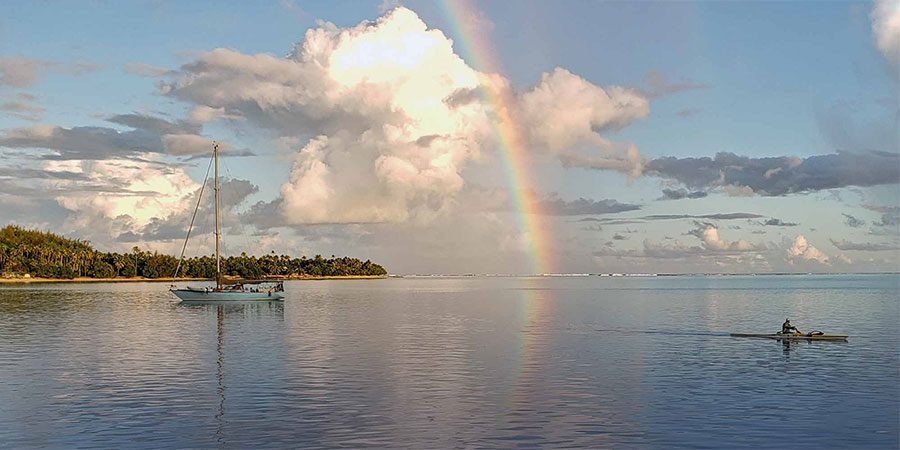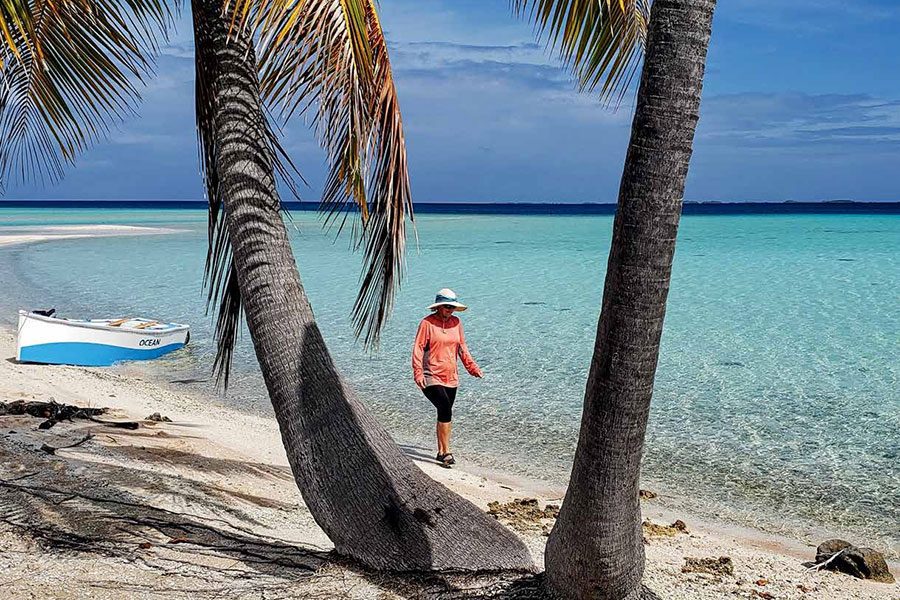

Tahiti and the Society Islands have always been many things to many voyagers: a dream, an aspiration, a paradise. What are they now?
Go ahead, say the word slowly and softly: Tahiti. That, friends, is the sound of Paradise.
No other island has the dream power of Tahiti – not Bali, not Hawaii, not the Seychelles, not anywhere. Over the past 256 years, ocean voyagers, starting with the 18th century European explorers – Samuel Wallis, James Cook, and Louis-Antione de Bougainville – have felt the island’s pull. Lured by tales of a magical idyll of volcanic spires, lush valleys, waterfalls, and sapphire lagoons, they found themselves entangled in an extraordinary culture, caught between island kings and hundreds of wakas, thousands of warriors in takeno-prisoners sea battles. And meanwhile, they were besotted by women beautiful beyond imagination. When the Europeans sailed away from Tahiti they must have wept and cried out, “What was that all about? Was it real? Was it a dream? How could such a place exist?”

Right now, the high, sharp silhouette of Tahiti is framed between OCEAN’s bows in the sunrise. Just twenty-four miles to go. What will we find? When I say Tahiti, of course, I am using cruiser shorthand for the Society Islands of French Polynesia, six isles west of Tahiti: Moorea, Raiatea, Tahaa, Huahine, Bora Bora, and Maupiti, plus a half-dozen small islands and motus. The neighbour islands are unique, as captivating as Tahiti but not as famous. Tahiti looms large among cruisers as a voyaging milestone and home to Papeete, the capital of French Polynesia and heart of the South Pacific. Sooner or later, every yacht calls into Papeete.
Some cruisers come to repair their boats, or to stock up with long-term provisioning, or for haul-outs, engine overhauls, sail repairs, and, of course, to buy stuff from marine chandleries. Some cruisers, worn out by years and thousands of miles of passage-making, come to sell their boats. Some crew, some spouses jump ship. Other boats load up with a rotating cast of fly-in family and friends and go off cruising the Societies. Some cruisers come to take a break from bluewater cruising: to tie up to a marina dock, to plug into shorepower and water, to enjoy meals at a real restaurant, to enjoy reliable internet and phone connections. On OCEAN, Harriet and I came for a bit of this and that, some of most of the above, and, like almost all cruisers, we stayed too long – three weeks – in Papeete.
Tahiti is lovely, but cruising? Every square metre of water seems to be occupied; every mooring taken. Papeete’s marinas are full, with waiting lists. The main ‘town’ anchorage, in the lagoon by the island’s always-busy airport, is crowded. In Port Phaeton, a hurricane hole at the southeast end of Tahiti’s main island, a fleet of cruising boats, left over from the Covid lockdown, are still at anchor, cruising plans paused or abandoned. During the Covid lockdown, Tahiti locals began to protest the invasion of homesteaders into their bays. But the island has recovered, most yachts have moved on, and tourism is again full-on.


The other reason we stayed in Papeete was Heiva i Tahiti, a two-week celebration of Polynesian heritage, the perfect answer to Bastille Day, the July 14 veneration of France and all things French, complete with a military parade. Heiva I Tahiti culminates in a six-day competition, staged in a waterfront open-air amphitheatre in front of thousands, and pulls you into the heart and soul of Polynesia. We were lucky to get tickets to an evening performance. Accompanied by rows of thundering drummers, 3,000 performers, 10 groups of cultural dancers and a dozen groups of traditional singers, told the stories and legends of Polynesia. Women in grass skirts, singing, heads and hips flower-garlanded, wove tales of love, loss, and rebirth across the generations. Phalanxes of men with war clubs and spears stomped and threatened their enemies. A chief, noble in robes and headdress, called out to his followers in Reo Mao ‘hi, the ancient language of Tahiti. The costumes, the choreography was spectacular: hundreds of dancers and warriors, moving in unison, gentle or fierce, the drumming hair-raising, overpowering. It was storytelling at its best. Harriet and I began to grasp what Polynesian culture was like, thousands of years ago, and how much it was changed by the arrival of Europeans. Right now, across all of Polynesia, local people are reclaiming their culture.
Still buzzing from Heiva i Tahiti, we slipped our Papeete dock lines. From Tahiti, cruisers look ten miles west to Moorea, another island of dreams. The iconic peaks at the head of the island’s world-famous bays, Baie de Cook and Baie Oponohu, envelop the anchorages – you can’t stop gazing at the volcanic, day-glo green spires. Lots of smaller anchoring spots, in sand banks out by Moorea’s barrier reef, are breezy, Technicolor affairs. But sadly, much of the coral is grey, dying or dead, due to climate change (elevated acidity and sea temperature) and pollution.


For first-time cruisers to the South Pacific, Moorea could be considered the queen of the Society Islands: the most eye-popping scenery, the widest variety of anchorages, plenty of hot restaurants and cool watering holes. But we’d cruised here 35 years ago, and now Moorea seemed a much more highly developed tourism product than before. Hotels and accommodation have appropriated most of the swathes of prime shoreline. This triangular island, only 10 miles across the top, is host to nine high-end resorts (such as Hilton, InterContinental, and Sofitel) and over 48 villas, fares, lodges, bungalows, and beach houses – and, naturally, all the tourist ‘experiences’ to go along with that. Tourists on blat-blatting rental Quad ATVs circle the island continuously. Packs of rental jet-skis blast through anchorages and snorkel spots. Cruise ships? They’re at the mouth of Cook’s Bay and Oponohu Bay, hovering.
Amazingly, for being so inundated by tourism, Moorea remains proudly Polynesian. Locals still return your wave. One day, Harriet and I rented e-bikes and circumnavigated the island, and we found that the southern two-thirds of Moorea, away from the resorts and tourist hordes of the northern bays, is country living, island-style. Poking into villages and side streets, we caught glimpses of daily life. Toddlers playing in a front yard, having a great time getting muddy. Boys and girls fishing for eels from a bridge. A BBQ, boom box, and a big family at a backyard party. Modest homes with concrete blocks and tin roofs, each with a well-tended garden of tropical bounty. And behind many ears, a fragrant tiare blossom, just because it is Tuesday – or Wednesday, or Thursday, or any day. People who live on Moorea smile because people have come from halfway around the world to see their island. And they are happy to welcome them and to share their home, Moorea, because that is the Polynesian way.

We stayed two weeks in Moorea, mostly dawdling in Cook’s Bay, close to a walking track, a popular-with-locals petit marché, and a popular-with-cruisers smoothie stand. But most cruisers have a schedule, sort of, and ours called for us to reach Fiji, which was about 1,800 miles away, by mid- to late-October to start looking for a weather window to New Zealand. Suddenly it was the first week of August; to see the rest of the Societies, we’d have to get a move on. So, we did.
As long as you are going east-to-west, with the prevailing NE, E, and SE trade winds, cruising the Societies is a great experience (west-to-east is a slog). A 78-mile overnighter took us into the wide reef pass into Fare, Huahine, the island’s only town, a working port with cargo being unloaded, ferries coming and going, a busy main street, and a scattering of small shops – a real place. In contrast to the Tuamotus and Marquesas (and in hopes of keeping the many charter boats off the coral) reef passes and lagoons in the Societies are well marked. We motored south inside the reef to the end of the island and Avea Bay, serene with acres of swinging room, fresh trade winds, surf whispering on the reef, and a small, low-key resort with a dinghy dock and great food. We stayed a week. We walked every day, strolling past kids and dogs and small settlements with ancient coral maraes. Huahine is a perfect example of South Pacific, laid-back life – a world away from the Resort Experience.

The sister islands of Raiatea and Tahaa (they share a barrier reef) are as laid-back as Huahine: deep, 20m-plus anchorages in deep coves, shallow sandy spots out by the reefs, small stores at small villages here and there. We pulled into Raiatea Carenage to remove, inspect, and retorque the port propeller, which was about to part company with the Volvo SailDrive. Nine months ago, a very pricey US boatyard had failed to use Loctite when installing the big locknut – a rookie mistake. When we discovered the wobbling prop back in Cook’s Bay, we lashed it through the slots in the SailDrive leg; ten minutes and some spare Dyneema string had saved us $500. We’d sailed to Huahine and Raiatea with only one engine – on a cat with two engines, that’s no problem.
The highlight of Raiatea for us was visiting Marae Taputapuatea, the largest marae in Polynesia and the hub of a voyaging network to the Societies and far beyond. The complex of stone platforms, a World Heritage site and testimony to 1,000 years of civilisation, covers an entire point of land. Marae Taputapuatea faces Te Ava Mo’a pass and the ocean beyond, acting as the departure and landing point for voyaging canoes to and from all over the South Pacific – including an island called Aotearoa, 2,300 miles southwest. Our efforts, on a boat of modern materials and with position-finding, weather, and communication technology at our fingertips, pales in comparison to these audacious feats of voyaging and navigation. How did they do it?

Aerial photographs of Bora Bora, our last stop in the Societies, are always stunning. From Raiatea, 22 miles away, Bora Bora’s twin peaks, massive volcanic brothers, are stunning. The clouds over Bora Bora, dyed green tint by the lagoon, are stunning. Even on a paper chart or electronic chart, Bora Bora is stunning. Oddly, the more removed from Bora Bora you are, the better it gets. Once we entered Passe Teavanui – and I realise how whiny and ungrateful this sounds – the island went from stunning to disappointing. Bora Bora is, at least to Harriet and me, the least appealing of the Societies. Why? Call it a takeover by resort; one dozen major resorts, most with over-water bungalows, have grabbed the best motus and former anchorages. To our eyes, the French government has let big hotel chains take over Bora Bora. But that’s progress. To fly-in or helicopter-in tourists, the place is amazing. To yachties, it is overdeveloped. I wonder what locals think of their island?
Brent and Beth, friends on Steel Away, a 56-foot steel ketch, tackled the heights of 661m Mount Pahia, Bora Bora’s second highest volcanic peak. A challenging climb, pulling themselves up ropes to get near the summit. They were rewarded with a memorable 360° view: the sweeping lagoon of Bora Bora, the perfect trio of Raiatea and Tahaa and Huahine and, wisps on the horizon, the promise of Moorea and Tahiti. That’s the kind of stunning image that they, and we, will keep in our minds. Tahiti and the Society Islands are still an accomplishment, a magnificent dream. Parts of it are blemished. Parts of it are Paradise.
It was time to head west. BNZ



